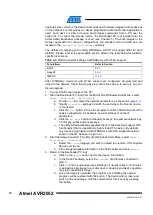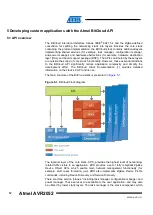
Atmel AVR2052
13
8200M-AVR-11/11
mediates the use of the MCU among internal stack components and user application.
The task manager utilizes a proprietary, priority, queue-based algorithm specifically
tuned for a multilayer stack environment and the demands of time-critical network
protocols. Power management routines are responsible for gracefully shutting down
all stack components, saving the system state when preparing to sleep, and restoring
system state when waking up. The configuration manager is used by the internal
stack components and the user application to provide a common way to store and
retrieve network parameters like the extended PAN ID and channel mask.
The hardware abstraction layer (HAL) includes a complete set of APIs for using on-
module hardware resources (for example, EEPROM, app, sleep, and watchdog
timers) as well as the reference drivers for rapid design-in and smooth integration with
a range of external peripherals (for example, IRQ, TWI, SPI, UART, 1-Wire
®
), where
the hardware interface is supported by the platform. The board support package
(BSP) includes a complete set of drivers for managing standard peripherals (for
example, sensors, UID chip, sliders, and buttons) placed on development boards,
such as those provided with Atmel ZigBit, Atmel ZigBit Amp, and Atmel ZigBit 900
evaluation kits.
Please refer to
for a more detailed description of the Atmel BitCloud API
and its features.
5.2 Development tools
A development toolchain consists of:
1. An integrated development environment (for example, Atmel AVR Studio
®
or IAR
Embedded Workbench
®
), where sample applications may be modified, compiled,
and debugged,
2. A corresponding compiler toolchain (for example, WinAVR, IAR™ or YAGARTO),
which provides everything necessary to compile application source code into
binary images, and
3. A programming device (for example, JTAG), which may be used to program and
debug the application on a target platform.
IAR Embedded Workbench for Atmel AVR
can be used to develop and debug
applications for AVR-based platforms, including ZigBit, megaRF, and Atmel XMEGA.
IAR Embedded Workbench for ARM and AVR32 can be used to develop and debug
applications on ARM-based platforms and 32-bit AVR platforms, respectively. All IAR
IDEs support editing of application source code, compilation, linking object modules
with libraries, and application debugging.
Atmel AVR Studio
can be used to develop and debug applications for AVR-based
platforms. AVR Studio is closely integrated with WinAVR – a Windows port of the
GNU compiler toolchain for the Atmel AVR microprocessors. More information about
WinAVR and GNU compiler tools is available in
and
and/or IAR Embedded Workbench for ARM
develop and debug applications based on the BitCloud API on Atmel SAM7X. Eclipse
IDE can be integrated with the YAGARTO compiler toolchain
seamless application programming and debugging on SAM7X, all inside Eclipse IDE.
In AVR Studio, each application has a corresponding project file identified by the
.aps
extension. All the necessary information about a project is contained in the
project file, which can be double-clicked to open the application’s project in AVR
Studio. Likewise, in IAR Embedded Workbench, each application has a
corresponding
.eww
file, which can be double-clicked to open the application’s














































